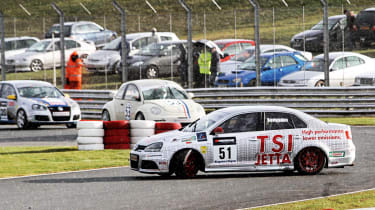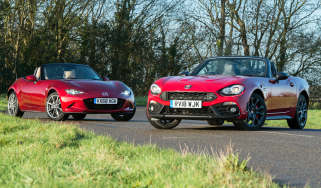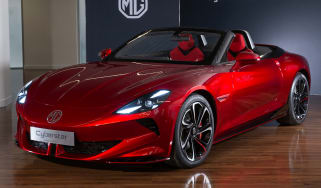How to go racing: 1
Track racing can be done on a reasonable budget and at a driving level to suit your skills
Going racing doesn’t have to be expensive, gaining a licence isn’t particularly complicated and competing at famous circuits such as Brands Hatch or Silverstone isn’t the sole preserve of karting champions. There is a massively wide choice of club level racing available and as long as you can drive a high performance road car you possess all the skills required to get started.
It’s seriously good fun and once you’ve taken those first few steps we guarantee you’ll never look back. The buzz from driving a race car is impossible to match and the adrenaline rush of competing is massively addictive. Only a racer knows just how good it feels to balance a car on the limit of its adhesion and to race wheel-to-wheel with fellow competitiors. You can become one and, take our word for it, it’ll be the most exhilarating thing you ever do. Furthermore, the off-track action is equally enjoyable, you’ll meet like-minded new friends who will offer help when you need it and share a beer at the end of the day.
Even if you already have a race licence you will find plenty in evo's trackday site section to help you make the right racing choice, for we have outlined all the main UK club racing championships and detailed typical budgets, the number of races per year, experience levels of the competing drivers, contact details for the championship organisers and much more. For specific queries our experts are on hand to help and offer advice in the trackday forum.
How good do I need to be?Of course, until you’re actually out on the track you won’t know your skill level, but as long you can handle a performance car on the road then you will be good enough to get started. Remember to give yourself time to learn and improve at your own pace. When you take the test to gain your licence you will need a basic understanding of the racing line and the technique required but this will be explained to you on the day.
Don’t expect to be on pole for our first race, but remember the driver who is out in front probably started their first race from the back end of the grid and steadily over time worked his way forward as they grew in experience. Everyone has to start somewhere.
Will I make a fool of myself? No. There will be trained instructors to help you on the licence test day, and the championship co-ordinator will help you at your first race meeting. It’s very likely that there will be plenty of other drivers on track for the first time and when you race it’s likely their will be other debutants and novice racers out there too. Each year hundreds of new drivers taking to the track for the first so you won’t be alone.
The only expectation from the examiner and the clerk of the course is that you have a safe and sensible approach to your racing. If you can do that you’re ready to go.
Is it safe?Yes. Modern circuits are designed with safety as the number one priority and all tracks in the UK have invested huge sums ensuring all racers are thoroughly protected. Circuits are subject to regular stringent checks, particularly if they host international meetings - the race meetings can only be held if they are up to standard. Most circuits massively exceed these requirements and run-off areas are larger than ever, as are the gravel traps. All meetings and test days are marshalled by trained volunteers, professional medical crews and doctors and most have fully staffed on-site medical centres too. If you do need assistance help will always arrive within seconds.
The Motor Sport Association (MSA) sets minimum safety standards for the equipment you must wear (which will be covered in detail later) and your car must have a specific specification of roll cage, harnesses and a fire extinguisher, all of which is examined closely during scrutineering. With all the safety requirements that both the cars and the circuit have to adhere to and the onsite medical facilities you are considerably safer on track than you are out on the road.
What age should I start racing?You can start whenever you want. Don’t think you’ve missed the opportunity because you didn’t start when you 14. Many new drivers begin racing in their forties and fifties once the kids have moved out and they have the time and funds to go and enjoy themselves. There are over 30,000 race licence holders in the UK and they span a wide range of ages. There is no upper age limit and many are still racing in their seventies.
Most people think you can only go racing once you have a road licence, but that’s not the case, you can actually start at 14 by applying for a junior race licence. There are a number of Junior Race Championships such as the Ginetta Juniors and the SaxMax championship. The organisers of each of these championships will provide you with all the information you need to get started.
How much will it cost?The all-important question… Really you need to decide how much you want to spend and then how you want to spend it. For example you but yourself a Mighty Mini racer and compete with for a whole season for around £5000 or alternatively you can easily spend in excess of £300,000 going touring car racing. Some drivers prefer to race just a few times a year concentrating their budget on larger events while others like to be out there every weekend.
Typically many club racers spend around £15,000 to £25,000 per year and often that budget is funded (partly or totally) by sponsorship. It’s an opportunity for friends, family and businesses to get involved and you can provide them with an exciting day out along with associated publicity.
With sportscars and historic racing to add to the huge list of single-seaters and tin-tops available, there really is something for every budget and it pays to spend time working out which option provides best value for you.
Taking the first stepsIf you have never been on track before it is advisable to either try an experience day where you will drive a fully prepared race car or a trackday where you can take your own road car on track. Both will give you a basic understanding of track driving and both are suitable for novices with one-to-one instruction available and provide the perfect introduction to track driving.
Once you have completed a couple of days you will be ready to apply for your race licence - you really don’t need to spend months or years pounding the tracks of the UK before going racing. In fact you will learn quicker this way than by spending endless hours testing, and it’ll be cheaper too.
All motorsport in the UK is governed by the Motor Sport Association (MSA) and the first thing you must do is send off for its 'Go Racing' pack which contains a Competitors’ Yearbook (known as the blue book), itemising specific regulations for all forms of motorsport and a video which details the next stage of the licence procedure. You will also receive that all-important licence application form. Log onto www.msauk.org for all the details and to order the pack.
Once you’ve received the pack and watched the tape the next stage then is to apply for your licence. Known as the ARDS (Association of Race Driving Schools) test it has to be carried out at a registered circuit, details of which are in the pack. You are required to undergo a half day of training before the test itself.
Taking the ARDS test Although it is a test, don’t worry. Gaining you licence is an enjoyable day during which to get to drive on track with an instructor, meet other novices and learn more about racing. It’s not a major hurdle either, the pass rate is very high and as long as you can demonstrate a basic understanding of the racing line and a reasonable technique you should achieve your goal.
The test day consists of two major elements; the track test and multiple choice, fifty question written paper. You will drive the race school cars and they can also provide you with a helmet if you do not have your own. Most circuits insist that your arms are covered, so wear comfortable clothing and thin-soled shoes.
When you are taking your test, the instructor isn’t looking to see how fast you can go, he will be looking to see if you understand the basics and that you will be safe. They have to ensure that you will be ok to drive on your own in a general test session, they are looking for both predictability and consistency and an awareness of traffic around you. Drive at a fast touring pace and keep things smooth. When taking the test ensure that you brake in a straight line with two hands on the wheel, use the full width of the track, do not adjust your line through a corner but look through it and your gear changing needs to be smooth and mechanically sympathetic. Most people pass first time, but if you don’t you will have to come back on another day to retake the test.
The written test is multiple choice and all the answers can be learnt from the video and section ‘J’ of the blue book. The questions are straightforward, but like all multiple choice questions you need to concentrate and read the questions carefully. If you fail this test you can retake it on the same day.
Finally, you will need to take a medical. If they are particularly busy some schools may book a doctor to come to the circuit to carry this out for you. If this is not the case then your local GP will be able to do it for you, usually for a fee of around £50. The medical is just a basic examination, where blood pressure will be checked along with your eyesight and medical history.
If you are over 45 years old you will also need to take an ECG test, which typically costs £200. If you are under 45 you will not need to have another medical (unless you have upgraded to an international licence) when renewing your licence, but above that age you are required to undergo the medical procedure annually.
At the end of that just send the paperwork to the MSA and you will have gained your National B race licence and you’re ready to go racing. Congratulations! All you need now is a car and you’re off on the start of a whole new chapter in your life, one where you can call yourself a racing driver.
How long is my new licence valid for?Just like your road licence you will not have to take this test again, however you will need to renew it at the start of each calendar year.
What does ‘National B’ mean?The vast majority of race championships in the UK are open to National B licence holders, including some high profile championships, such as Formula Palmer Audi and the Radical Enduro series. For your first six races you will be required to have novice sticker (yellow square with a black cross) attached to the back of your car so the other drivers are aware that you are just starting your racing career. After each race the Clerk of the Course will sign the back of your licence and when you have six of those you may peel off your novice sticker and you are eligible for a National A grade licence.
I’ve got my licence, but what clothing do I need?Just like the championships now open to you there is a vast array of clothing options available. The MSA require you to wear a suit and helmet and both have to be of a certain quality and standard and this will be checked in scrutineering. It is quite possible to spend thousands of pounds on this kit but for you first race meeting you really don’t need Formula One specification items. As long as it meets the strict standards set down by the MSA it will be perfectly adequate for your requirements. You should be able to get fully kitted out and look the part for between £300 and £500, although you can spend more than double that if you want the very best (check out our racesuit feature for a detailed explaination to the work that goes into the suits, boots and gloves).
The helmet must meet standard Snell SA2005 and there are more details in the MSA blue book section Q10. Of course, your local supplier will also be able to advise you on this, too, as well as ensuring you buy the correct size. There are two types of helmet - open and full face. Full face is a requirement for single-seaters and most drivers also wear these in saloons, too, as they offer increased protection (and it means you do not need to by a new helmet if you change your plans and decide to move to single seaters). The race suit also needs to conform to a standard and come in single-, double- or triple-layer nomex. Again the specialist shop will advise on the exact specification you require, most drivers also wear nomex underwear and balaclavas too. It's also advisable that you wear race boots and gloves to complete your fire protection (standard ISO 6940) and to ensure you have plenty of feel with the steering wheel and pedals.




